| Federation Alliance | Breen-Dominion Alliance |
"No, you do not. There was no honor, just massacres."
The Dominion War was a major interstellar conflict, fought from 2373 to 2375, though related conflicts began earlier. The war involved all major powers of the Alpha and Gamma Quadrants, organized into two opposing military alliances: the Federation Alliance and the Breen-Dominion Alliance. Marked by massive military and civilian casualties, including the systematic destruction of the Cardassian population (in which more than eight hundred million Cardassians were killed), and the mobilization of starship fleets on a massive scale, it was one of the bloodiest and most destructive wars in modern galactic history.
Prelude[]
- Main article: Dominion Cold War
Following initial Alpha Quadrant expeditions into the Gamma Quadrant, rumors began to filter through of a ruthless race of conquerors known only as "The Dominion". In 2370, first contact was officially made between the Federation and the Dominion, when the Jem'Hadar destroyed the Starfleet vessel USS Odyssey. A state of cold war rapidly developed thereafter between several of the Alpha Quadrant's major powers and the Dominion. A Dominion invasion was widely regarded as inevitable, as the Founders were driven by a xenophobic need to exert absolute authority over all other civilizations. (DS9: "The Search, Part II")
The Dominion began to infiltrate the Alpha Quadrant with Changelings masquerading as important officials, in an attempt to destabilize the political landscape between the major powers. By manipulating a plan originating with Enabran Tain, the Dominion completely destroyed the Obsidian Order and nearly completely destroyed the Tal Shiar at the Battle of the Omarion Nebula in 2371. The subsequent power vacuum left in the absence of the Obsidian Order led to a coup on Cardassia, resulting in the overthrow of the Cardassian Central Command by the Detapa Council.
By manipulating frustrated warrior sentiments in the Klingon Empire and implanting false information that the Cardassian change of government had been engineered by the Founders, the Dominion was able to trigger the Klingon-Cardassian War. The Federation condemned the Klingon invasion, leading to a severe deterioration of relations between the two powers, ultimately concluding with the Federation-Klingon War.
Concurrently, the Dominion was almost able to instigate a war between the Federation and the Tzenkethi and caused mass hysteria on Earth following the bombing of the Antwerp Conference in 2372, which in turn led to a failed coup attempt of Starfleet personnel under Admiral Leyton. (DS9: "The Die is Cast", "The Adversary", "The Way of the Warrior", "Apocalypse Rising", "Homefront")
As part of a preemptive defensive effort, the Trill government cooperated with Starfleet in trying to seal the wormhole permanently in 2373, without damaging the beings living within. The attempt was sabotaged by a Changeling infiltrator disguised as Julian Bashir. The Bashir Changeling was stopped by the crew of the USS Defiant in his attempt to destroy the Bajoran sun, which would have killed all life in the system and destroyed the Federation, Klingon, and Romulan fleets that were at Deep Space 9 at the time. (DS9: "In Purgatory's Shadow", "By Inferno's Light")
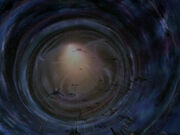
The Dominion invades the Alpha Quadrant
The Klingon invasion of Cardassia had all but destroyed Cardassian infrastructure. In mid-2373, frustrated at the apparent cowardice of the Detapa Council, and the broken state of the Cardassian people, Gul Dukat negotiated the entry of the Cardassian Union into the Dominion. Dukat himself was placed as head of the new Cardassian government. The Dominion rapidly began fortifying Cardassia with heavily armed convoys on a weekly basis. Within three days of their arrival, the Jem'Hadar had expelled the Klingons from Cardassian space entirely, and completely annihilated the Maquis in the Demilitarized Zone. In the face of the new Dominion foothold in the Alpha Quadrant, the Federation and the Klingons renewed the Khitomer Accords. (DS9: "By Inferno's Light", "Blaze of Glory")
Although open war did not begin immediately, violence along the Cardassian border escalated, with ships such as the USS Tian An Men and the IKS B'Moth being reported missing, though both were later located. The Dominion began making strategic political inroads in the Alpha Quadrant, signing nonaggression pacts with the Tholian Assembly, the Miradorn, Bajor, and, perhaps most significantly, the Romulan Star Empire. With five large convoys having entered the Alpha Quadrant unopposed, the Federation Alliance realized they would soon face an impossible strategic position.
In late 2373, the Federation thus decided to mine the entrance to the Bajoran wormhole with self-replicating mines in a last-ditch effort to permanently stop the flow of Dominion reinforcements into the Alpha Quadrant. Both sides knew that this act would lead to open war. (DS9: "Soldiers of the Empire", "In the Cards", "Call to Arms")
Open war begins[]
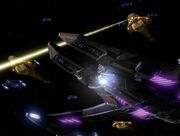
The first shots of the Dominion War, fired on Deep Space 9
Main article: Second Battle of Deep Space 9
Intent on preventing the Federation from completing the minefield, Weyoun arrived on Deep Space 9 and delivered an ultimatum; either Sisko would remove the mines, or the Dominion would. Sisko refused the ultimatum, and, two days later, a large Dominion and Cardassian Union fleet attacked and captured Deep Space 9. Trusting that the minefield would be activated in time, the Federation Alliance opted not to reinforce the station but used the opportunity to take advantage of the diverted Dominion ships to destroy the Dominion shipyards at Torros III. Though the minefield was successfully activated, the Alliance were forced to retreat from the Bajoran system, and the station was subsequently garrisoned by Dominion forces. (DS9: "Call to Arms", "Behind the Lines")
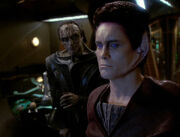
Dukat and Weyoun confer over Dominion strategy
Over the following months, Federation forces were forced to retreat on all fronts in the wake of several decisively successful Dominion campaigns. At each instance, the Allies suffered catastrophic losses. During this campaign, Starfleet suffered one of its worst defeats of the war when the Seventh Fleet was dispatched to halt the Dominion's advance at the Tyra system. In the subsequent battle, 98 starships were destroyed out of a fleet of 112, leaving thousands dead. Morale among the forces of the Federation Alliance plummeted, and it became a question of when, not if, the Alliance would be defeated. (DS9: "A Time to Stand")
While the Alliance suffered repeated defeats in large fleet actions, Federation and Klingon ships had greater success in raiding operations and in combating small patrols of Jem'Hadar ships. Such operations included the destruction of the Dominion's primary ketracel-white storage facility in the Alpha Quadrant, and the destruction of a massive Dominion sensor array in the Argolis Cluster. The Dominion began suffering a shortage of ketracel-white, greatly concerning the Cardassians in particular. Glinn Damar even proposed that the last rations of white be poisoned if new supplies could not be secured, preventing the Jem'Hadar from running amok.
Nevertheless, the Dominion continued to conquer large swathes of Federation and Klingon territory, even approaching the Vulcan border and Bolian territory. On Deep Space 9, efforts to dismantle the minefield surrounding the wormhole were finally beginning to bear fruit. Although Alliance forces scored several minor successes in single-ship duels and in small groups, the inexorable Dominion advance compelled them to continually retreat. Morale sunk lower, with even the Klingons doubting they could defeat the Dominion. (DS9: "Behind the Lines", "Favor the Bold")
Counter-offensive[]
By the latter half of 2374, the Federation and Klingon Empire were perilously close to defeat. A major victory was needed, if anything to boost morale. Captain Benjamin Sisko, knowing the Dominion would likely figure out how to disable the minefield eventually, proposed to Starfleet Command the Federation Alliance had to go on the offensive. Sisko's plan was to assemble a task force to recapture Deep Space 9, the most strategically important site in the Alpha Quadrant, at the mouth of the wormhole. Despite misgivings that it would leave Earth vulnerable, Starfleet approved the plan.
The Klingons proved more difficult to convince; Chancellor Gowron held the same concerns as Starfleet, in committing as many ships as would be required to re-take Deep Space 9, it would leave the Empire vulnerable. While General Martok and Lieutenant Commander Worf made Starfleet's plea to Gowron in person, Federation forces began assembling at Starbase 375. Unfortunately, Starfleet soon received intelligence from active resistance members on Deep Space 9 that the minefield was only three days from being destroyed.
With no word having arrived from the Klingons, and only two-thirds of the Starfleet force assembled, Vice Admiral William Ross authorized Benjamin Sisko to lead the 627 ships assembled in an effort to prevent the Dominion from removing the mines. In response, Dukat pulled 1,254 warships from the front lines to intercept the Federation fleet, stalling Dominion advances into Allied territory. (DS9: "Favor the Bold")

Klingon warships in combat during Operation Return
Though outnumbered two to one, Starfleet engaged the Dominion fleet. With the timely arrival of Klingon forces, the Dominion lines collapsed, and the fleet dispersed. Though the USS Defiant breached the lines, it was unable to prevent the destruction of the minefield. With no options remaining, Sisko took the Defiant into the wormhole and was able to strike a bargain with the Prophets to remove the Dominion forces to protect Bajor. The 2,800 Dominion ships in the wormhole disappeared, and with two hundred Alliance ships approaching Bajor, the Dominion position on Deep Space 9 became untenable. The Dominion withdrew all forces to Cardassian territory, giving the Alliance forces a decisive victory.
Dukat suffered a mental breakdown at the defeat, along with the concurrent murder of his daughter, Tora Ziyal, and was captured by the victorious Federation and Klingon forces. Damar was subsequently promoted to gul and succeeded him as leader of the Cardassian Union. (DS9: "Sacrifice of Angels")
Lull[]
Following the decisive Allied victory in recapturing Deep Space 9, the Dominion forces withdrew to Cardassian space, and major operations temporarily ceased. (DS9: "Resurrection") Gul Damar extended an olive branch to the Federation, hoping to negotiate a cease fire and end the war. Weyoun proposed to redraw the Federation-Cardassian border to give disputed star systems to the side with de facto control, an arrangement which generally favored the Federation. However, a think-tank of genetically-engineered individuals led by Julian Bashir deduced that the Dominion's true goal was to obtain the Kabrel system. Though strategically unimportant, the Kabrel system contained a tri-nucleic fungus that could be processed to allow the Dominion to produce near-endless amounts of ketracel-white.
Bashir advised that the Federation accept the peace proposal; while many suspected the Dominion would renege on any agreement to buy time to re-group, the Allies were in a far greater need of a respite than the Dominion. Instead, the Federation made a counter-proposal and the talks ended inconclusively. (DS9: "Statistical Probabilities")
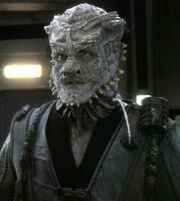
Kudak'Etan, one of the first Alpha Jem'Hadar
Several weeks later, Dominion activity began to increase all along the border, putting to rest hopes that the Allied recapture of Deep Space 9 would signal the end of the war. Allied losses began to mount, including the destruction of the USS Honshu and the USS Cortez. (DS9: "Waltz", "Far Beyond the Stars") In an effort to weaken the Federation-Klingon alliance, Dominion agents established ties with the Orion Syndicate in an unsuccessful plot to assassinate a Klingon diplomat opposed to the war and frame the war proponents led by Gowron for it. (DS9: "Honor Among Thieves")
With the Prophets barring passage of the wormhole to ships from the Gamma Quadrant, the Dominion began breeding legions of Jem'Hadar, tailoring their genetic profiles specifically for combat in the Alpha Quadrant, and pushed their shipyards to full construction capacity. (DS9: "One Little Ship", "In the Pale Moonlight", "The Reckoning") The issue of a possible ketracel-white shortage became less imminent when the Dominion acquired new supplies of the drug manufactured by the Son'a. (DS9: "Penumbra"; Star Trek: Insurrection)
Having recovered from the loss of Deep Space 9, in late 2374, the Dominion launched a surprise invasion of Betazed from the Kalandra sector, capturing the planet in less than ten hours. With control of this key Federation member world, the Dominion had scored a decisive strategic success; it was now in a position to launch offensives against Vulcan, Andor, Tellar, and Alpha Centauri. The Second Fleet launched three counterattacks in just one month against Betazed; however, all were repulsed. For the Federation Alliance, suffering from shortages of ships and manpower, defeat once again seemed only a matter of time. (DS9: "In the Pale Moonlight", "The Sound of Her Voice")
The tide turns[]
The Romulan Star Empire had hitherto remained neutral in the Dominion War, although they were turning a blind eye to Dominion warships crossing through their territory to ambush Federation convoys and shipping. Captain Benjamin Sisko reasoned that the addition of the Romulan military could prove decisive in reversing the fortunes of the Dominion. With the help of Elim Garak, and the approval of Starfleet, a covert mission was carried out to implicate the Dominion in a planned invasion of Romulus; however, Garak used this operation for the assassination of Senator Vreenak, the most ardent pro-Dominion advocate in the Romulan Senate. From the wreckage of Vreenak's destroyed ship, the Tal Shiar recovered a recording of an alleged top-level Dominion conference bringing forward the planning of the invasion.
In response, the Romulan Empire officially declared war on the Dominion. Within hours, the Romulans struck fifteen bases along the Romulan-Cardassian border, opening the Romulan front to the war. Although progress remained slow for the allies, the Romulans drove Dominion forces off of Benzar within months of joining the war effort. During the Romulan fight against the Dominion, Shinzon distinguished himself in the Romulan military, leading twelve major engagements against the Jem'Hadar, all of them successful. The Remans were also used as heavy assault troops and cannon fodder for the most violent encounters during the war. (DS9: "In the Pale Moonlight", "The Reckoning"; Star Trek Nemesis)
The Federation, desperate for additional support, continued to extend diplomatic ties to neighboring species. (DS9: "In the Pale Moonlight") In 2374, the Federation Council conveyed an official diplomatic message to Grand Nagus Zek of the Ferengi Alliance, which Jake Sisko speculated was a proposal for an alliance. (DS9: "Valiant") In 2375, the Federation accepted the Evora as a protectorate, despite their having achieved warp drive only the previous year. (Star Trek: Insurrection)
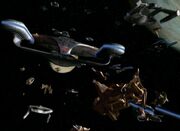
The Federation Alliance captures the Chin'toka system in 2374
With the Romulans now fully committed to the Federation Alliance, options for a general offensive into Cardassian territory became a viable possibility. The Romulans had reservations that such an attack could succeed only at horrendous cost, favoring to contain the Dominion within Cardassian space. However, Benjamin Sisko convinced their delegation that the only course to victory was to destroy the Dominion's military-industrial complex itself. The Allies agreed they would commit their efforts to the Chin'toka system, its defenses having recently been thinned to provide additional support for the Romulan front.
In late 2374, the Federation Alliance launched their first offensive into Cardassian space, capturing Chin'toka after a hard fight. (DS9: "Tears of the Prophets") Although the planned attack against Cardassia itself was not realized, owing to heavy losses taking Chin'toka, the successful invasion was a tremendous boost to Allied morale. The Allied hold on Chin'toka was tenuous at best; the system remained under almost constant attack, making it extremely difficult to reinforce the garrisoned forces. Further offensives were bloodily repulsed; a Klingon fleet lost thirty percent of its strength attacking Monac IV. (DS9: "Image in the Sand", "The Siege of AR-558")
On other fronts, the Allies enjoyed greater success. Elim Garak began working for Starfleet in an unofficial capacity breaking Cardassian military codes; one such breach enabled the Allies to retake the Kalandra system from the Dominion. (DS9: "Afterimage", "The Emperor's New Cloak") While the Allies consolidated their new front, General Martok launched a deep penetration raid into Cardassian space that damaged several key military targets. (DS9: "Once More Unto the Breach")
Meanwhile, while the Ferengi maintained a sense of neutrality, the Grand Nagus was nevertheless kept up-to-date on the war efforts by Starfleet through their intelligence reports. In 2375, he sent Quark on a fact-finding mission to the front lines, specifically the Chin'toka system, aboard the Defiant. However, according to Quark, "If the Federation had listened to the Ferengi Alliance there never would have been a war, [...] [as they] would have reached an accommodation. We would have sat across the negotiation table and hammered out a peace treaty. One that both sides could live with." He later quoted the 125th Rule of Acquisition to justify such reasoning, "You can't make a deal if you're dead." (DS9: "The Siege of AR-558")
In 2375, the Federation learned of a development that would ultimately help determine the course of the war: a deadly morphogenic virus had infected the Great Link. Despite the Dominion's technological prowess, they were unable to find a cure, and it was determined it would only be a matter of time before the Founders would die. (DS9: "Treachery, Faith and the Great River") It was later discovered that the virus had been engineered by Section 31, a rogue branch of Starfleet Intelligence. Although Julian Bashir did find a cure, the Federation Council decided to withhold it from the Dominion for strategic concerns. Some protested this act as abetting genocide. (DS9: "Extreme Measures", "The Dogs of War")
Cardassian rebellion[]
Meanwhile, the Alliance's slowly encroaching front-line had begun to seriously strain relations in the precarious Dominion-Cardassian alliance. The Founders and their Vorta underlings tended to rest blame upon the Cardassian military for the defeats on the frontlines, an accusation that Damar, now promoted to legate, found particularly galling. Many Cardassian soldiers grew distrustful and resentful of the Dominion, while the Dominion continued to erode Cardassian autonomy.
Seeking to rescue the war effort, in mid-2375, the Dominion conducted secret negotiations with the elusive Breen Confederacy to propose a military alliance; negotiations which the Cardassians were not privy to. The Dominion granted the Breen unspecified Cardassian territorial concessions in exchange, concessions which Legate Damar had neither seen nor agreed to. His objections were summarily overruled. (DS9: "Penumbra", "'Til Death Do Us Part")
Damar grew concerned with further Allied advances, specifically the garrison of the Eleventh Order on Septimus III, which would fall without Jem'Hadar assistance. The Dominion refused to render aid, regarding it as an acceptable sacrifice. The Klingons subsequently invaded the planet and massacred the garrison. This action finally spurred Damar to rebel against the Dominion. (DS9: "Strange Bedfellows", "The Changing Face of Evil")
The Breen Confederacy entered the war in late 2375 with a bold raid on Starfleet Headquarters. This sent shock waves through the Alliance.
In ultimately unused dialogue from the first draft script of "The Changing Face of Evil", Miles O'Brien and Julian Bashir speculated that there was "a good chance" that the Federation Alliance would lose the war, with they themselves being killed in the process.
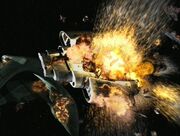
Allied ships are annihilated during the Breen counterattack on Chin'toka
Now able to mobilize a large fleet to carry out offensive operations, the Breen-Dominion Alliance launched a massive counterattack against the Chin'toka system. The battle would prove to be the worst Allied defeat of the entire war; of the 312 ships engaged, all but one were destroyed. However, they could not press their advantage, as soon after, the Cardassian Liberation Front attacked the Dominion military installations on Rondac III, diverting vital resources from the front. (DS9: "The Changing Face of Evil")
The only Allied warship to escape the Breen energy dissipaters at Chin'toka was a Klingon warship, the IKS Ki'tang, owing to a chance modification of the ship's tritium intermix. General Martok ordered the modifications across the entire Klingon fleet and had 1,500 warships ready for deployment the following day. With the Federation and Romulan fleets effectively useless in the interim until a countermeasure could be developed, the Klingons were left with the daunting task of holding the front-line against the Breen-Dominion Alliance. (DS9: "When It Rains...")
However, the Allied defensive efforts were soon jeopardized by Chancellor Gowron, who believed his political position had become threatened by Martok's popularity in the Empire. Gowron took direct command of the Klingon fleet and repeatedly ordered Martok on hopeless attacks, intending for him to be killed or disgraced. With the safety of the Alpha Quadrant at stake, Benjamin Sisko ordered Lieutenant Commander Worf to deal with Gowron. Worf directly challenged his leadership and slew him in single combat. Worf then proclaimed General Martok as the next Chancellor of the Klingon High Council. (DS9: "Tacking Into the Wind")
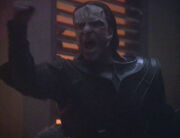
Damar rallying the Cardassian people against the Dominion
Meanwhile, the Federation Alliance saw a strategic opportunity in the Cardassian rebellion to keep the Breen-Dominion Alliance constantly off-balance. The Federation supplied replicators, weapons and food supplies to the rebels, and dispatched Kira Nerys to train Damar's troops in guerrilla tactics. (DS9: "When It Rains...")
The Cardassian rebels began carrying out a number of sabotaging attacks on Dominion ships and military installations and were able to deliver a functioning Breen energy dissipater to the Allied forces. (DS9: "Tacking Into the Wind") Unfortunately, however, the success of Damar's revolt was short-lived. Gul Revok, who allegedly wanted to defect to the rebels, betrayed them to the Dominion. Jem'Hadar and Breen ships rapidly destroyed all eighteen rebel bases, ending the organized resistance against the Founders' rule. (DS9: "The Dogs of War")
Invasion of Cardassia[]
Although the Cardassian military rebellion had ostensibly been crushed, Starfleet and Romulan engineers were able to develop a countermeasure to the Breen energy dissipater, thus denying the Dominion of their one major tactical advantage over the Allies. Facing a renewed counter-offensive on a wide front, the Dominion-Breen forces withdrew from all conquered territories and established a fortified perimeter within Cardassian space. Their hope was that the Allies would balk at the cost of breaching the perimeter, giving the Dominion time to rebuild.
While containing the Dominion within its present borders was a tempting move, the senior Allied commanders argued the Dominion could not be afforded any respite. Instead, the Allies would mobilize all their available ships to launch a single, decisive strike against the heart of Dominion power in the Alpha Quadrant: Cardassia. (DS9: "Tacking Into the Wind", "The Dogs of War")
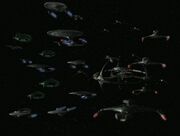
The Allied fleet departs Deep Space 9 to invade Cardassia
On Cardassia itself, the remnants of the resistance had not been idle. The bold revolt, though ultimately defeated, had left a scintillating impression upon the Cardassian people. Buoyed with this knowledge, Damar, Garak, and Kira Nerys successfully bombed a Jem'Hadar barracks, rallying the civilian population into a popular uprising against the Dominion.
Meanwhile, the Allied fleet crossed into Dominion space and engaged the Dominion-Breen forces in battle. Concurrently, popular revolt on Cardassia sabotaged the planet's power grid, cutting off transportation and communication systems, causing a planetary blackout. The fleet defending Cardassia was completely cut off from Dominion Headquarters. In retaliation, hoping to discourage further attacks, the Jem'Hadar destroyed Lakarian City, killing two million civilians. Instead, it had the opposite effect; the Cardassian military abrogated their alliance, fracturing the Dominion lines, forcing it to retreat. Infuriated, the Female Changeling ordered the Jem'Hadar to exterminate the Cardassian population.
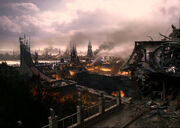
Cardassia Prime in ruins after the Jem'Hadar bombardment
While the Jem'Hadar rampaged across the planet, the Dominion-Breen fleets in orbit of Cardassia were ordered to fight to the death, ensuring only a pyrrhic Allied victory. As the Allies laid siege to Cardassia, rebels breached Dominion Headquarters, capturing the Founder. Odo convinced the Founder to surrender rather than fight; in exchange he would return to and cure the Great Link of the morphogenic virus. The Founder agreed, and the Dominion forces surrendered; the first time it had ever done so in battle. (DS9: "What You Leave Behind")
Aftermath[]
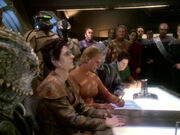
The Treaty of Bajor is signed on Deep Space 9
"Suddenly I'm not thirsty."
"Neither am I."
The instrument of surrender, the Treaty of Bajor, was signed on Deep Space 9 between representatives of the Federation Alliance and the Dominion several days after the surrender at Cardassia. The treaty stipulated the Dominion would effect a complete military withdrawal to the Gamma Quadrant, while Alpha Quadrant territories were reverted to their boundaries as of stardate 50564.0, just prior to the Dominion's initial incursion into the Alpha Quadrant. (DS9: "What You Leave Behind")
The Dominion War significantly shifted the power dynamics of the Alpha Quadrant. The Cardassian Union had collapsed completely and Cardassia Prime was left in total disarray; over eight hundred million civilians had been killed by the Jem'Hadar in mere hours, in addition to over seven million troops during the war, and the leading figures in both Cardassia's official and underground governments had been killed. The Breen Confederacy had shown both its impressive military and technological capabilities and its desire for violent expansion.
The Klingon Empire, having previously suffered heavy casualties in the conflicts with the Cardassians and the Federation, was projected to focus on recovering from the war for a decade. The two remaining major powers were the Federation and the Romulan Star Empire. Romulan relations with the Federation declined after the war, with the Federation embargo on Romulan goods reinstated.
This resumption of pre-war attitudes would last until 2379, when a military coup led by noted Dominion War commander Shinzon of Remus planned to commit a genocidal attack on Earth. Shinzon's defeat gave the Federation hope for improved relations with the Romulan Star Empire. These hopes however died in 2385, when a Zhat Vash infiltrator in Starfleet orchestrated a devastating attack on Mars in order to turn public opinion against artificial lifeforms. Although the Zhat Vash's involvement would not be exposed for another 14 years, the attack, combined with preexisting political pressure, caused the Federation to abandon efforts to relocate nine hundred million Romulans to safety from the impending supernova of the Romulus. (DS9: "Inter Arma Enim Silent Leges", "What You Leave Behind"; Star Trek Nemesis; Star Trek; ST: "Children of Mars"; PIC: "Remembrance", "The End is the Beginning", "Broken Pieces", "Et in Arcadia Ego, Part 2")
In the Gamma Quadrant the order of the Dominion was maintained when Odo, fulfilling his pledge to the Female Changeling, did indeed return to the Great Link thus curing it of the morphogenic virus. (DS9: "What You Leave Behind")
After the war, Starfleet established a standard protocol by which all personnel were required to pass through an internal imaging chamber before reporting, to check that they had not been replaced by a Changeling. (PIC: "Imposters")
Only five years after the war's conclusion, at least one Starfleet officer, Lieutenant Steve Levy, maintained a conspiracy theory that Changelings were not real and "the Dominion War didn't happen." (LD: "No Small Parts")
Beckett Mariner developed survivor guilt partially as a result of fighting in the Dominion War, and later cited the war as a reason for her self-destructive behavior. (LD: "The Inner Fight")
Renegade Changeling faction[]
Some time after the Dominion's surrender, the Great Link fractured, with a rogue faction vowing to continue fighting against the Federation. In 2401, Starfleet was aware of the Changeling rebels yet kept that information secret out of fear that the news would result in calls for the Federation to go to war against the Dominion again. Much of this faction was wiped out when the USS Titan-A destroyed the Shrike and their leader Vadic was killed. Before her death, Vadic revealed that she had been one of ten prisoners of war during the Dominion War and had been experimented upon during Project Proteus, resulting in her enhanced abilities that she and the others had spread to the rest of her faction. (PIC: "Seventeen Seconds", "Surrender")
The renegade Changeling faction's full plans were later revealed to be a deadly alliance with the Borg Queen, who was, like the Dominion, an enemy of the Federation whom Starfleet had defeated. The Queen used her Changeling allies to plant an assimilated DNA that was within Jean-Luc Picard's Human corpse inside of Starfleet's transporter code in order to covertly assimilate all Starfleet officers under the age of 25 (and the biological equivalent for non-Humans). The plan did succeed briefly, until Admiral Picard and his crew used the recently rebuilt USS Enterprise-D to save Jack Crusher, Picard and Beverly Crusher's son, who was being used by the Borg as a transmitter for the Collective to the assimilated officers. Picard and his crew succeeded, and the Borg Collective - decimated by a neurolytic pathogen years earlier by USS Voyager - was finally destroyed by the Enterprise.
After the Borg's final destruction, Admiral Crusher as the new head of Starfleet Medical, developed a transporter solution to eliminate Borg DNA from the infected officers as well as a method of detecting the modified Changelings, thus exposing the remaining infiltrators for arrest. Starfleet discovered that the Changelings had kept many of the officers whom they had replaced alive, including Captain Tuvok, and were able to find and rescue them, bringing a final end to the rogue Changelings plans. (PIC: "Võx", "The Last Generation")
| Major battles of the Dominion War |
|---|
| 2373: Second Battle of Deep Space 9 • Battle of Torros III |
| 2374: Battle of the Tyra system • Operation Return • Battle of Betazed • Liberation of Benzar • First Battle of Chin'toka |
| 2375: Destruction of Monac shipyard • Raid on Trelka V • Siege of AR-558 • Battle of Ricktor Prime • Invasion of Septimus III • Breen attack on Earth • Second Battle of Chin'toka • Battle of Rondac III • Attack on Avenal VII • Battle of Cardassia |
| Klingon wars |
|---|
| Federation War (2256-57) • Federation War (2267) • Klingon Civil War • Cardassian War • Dominion cold war • Federation War (2372-73) • Dominion War • Federation War (2340s-2366) |
Appendices[]
See also[]
Appearances[]
- DS9:
- "Call to Arms" (Season 5) (First appearance)
- "A Time to Stand" (Season 6)
- "Rocks and Shoals"
- "Sons and Daughters"
- "Behind the Lines"
- "Favor the Bold"
- "Sacrifice of Angels"
- "Waltz"
- "One Little Ship"
- "Honor Among Thieves"
- "In the Pale Moonlight"
- "Valiant"
- "Tears of the Prophets"
- "Once More Unto the Breach" (Season 7)
- "The Siege of AR-558"
- "Penumbra"
- "'Til Death Do Us Part"
- "Strange Bedfellows"
- "The Changing Face of Evil"
- "When It Rains..."
- "Tacking Into the Wind"
- "The Dogs of War"
- "What You Leave Behind"
Background information[]
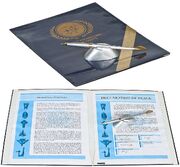
The Treaty of Bajor prop
Ira Steven Behr and Ronald D. Moore were the writers most involved with the creation and development of the Dominion War. Rick Berman wanted the war to be over within three or four episodes at the most. Behr and Moore knew the series would never be able to wrap up the war in that many episodes. Berman also criticized the "depressing" and "violent" stories. Moore later said "It's a fuckin' war! What do you mean it's too violent?!" [1](X)
Behr commented in 2019: "Everyone loves the Dominion War. But the Dominion War could have played out with an even bigger arc. There was lots of horse trading to even get what we were able to accomplish in terms of the Dominion War. It would have been great to make it more serialized as well". [2]
Peter Lauritson commented: "DS9 was also where we really showed the Starfleet armada for the first time, with big fleet-type shots and big ship battles. I think that remained the only place where you saw that scale of encounters between the different factions, between the Dominion and the Cardassians and the Federation and its allies". (Star Trek: The Official Starships Collection, issue 147, p.14)
Armin Shimerman had hoped to have seen the Ferengi involved more in the Dominion War arc. Shimerman commented: "It would have been very interesting to see how people made profits off of wars, to see a black market during the war, to see how the Ferengi, who were basically neutral during the war, behaved. We did a bit of that but we didn't delve into that as much as we could have". ("The Once and Future Ferengi: Armin Shimerman Reflects on Quark", Star Trek: Communicator issue 130)
Majel Barrett criticized the arc in a letter published in Star Trek: Communicator,(citation needed • edit) claiming that Gene Roddenberry would have never approved of a continuing war in a Star Trek series. Berman has espoused similar sentiments, noting that his opposition "was all based purely on the fact that Gene had been very specific to me about not wanting Star Trek to be a show about intergalactic wars, interspecies wars. He didn't want it to be about Humans fighting wars against other species." [3] Responding to the former, Moore admitted, "She's probably right. It would've been very hard to argue Gene into going this way and maybe he'd have never gone for it. However, I would've still argued for doing the Dominion War with him and if he'd rejected it, I would've thought he was wrong. I respect Gene and his work, but I don't think he was always right and I'm not going to pretend that I do. The Dominion War has been one of the better storylines we've come up with whether Gene would've agreed or not." (AOL chat, 1999)
Bjo Trimble commented: "I feel that Gene might have come to like DS9, had he lived to see it. There might have been some changes. Majel recently said that GR would have hated the war in DS9, but frankly I am amazed that she cannot see the same theme in much of what Gene did, including his recent "discovery" of Earth: Final Conflict. The only reason there were not full battles in early Trek is lack of funds to pull it off, and lack of technology to show it. Otherwise, GR would certainly have added it; he knew what audiences liked. I don't know about Voyager; I can't see where it's going, and I don't feel GR would have liked that. I don't think he would have liked the last couple of movies; they were very far removed from the Trek Gene came up with." [4]
The Dominion War was directly referred to on four occasions outside of Deep Space Nine: VOY: "Message in a Bottle", Star Trek: Insurrection, Star Trek Nemesis and LD: "No Small Parts".
Michael Chabon of Star Trek: Picard commented that the writers "tried to work [the war] in several times, in drafts. Wiser heads argued correctly that it made things just that much more intimidatingly complicated for non-fans". [5]
Apocrypha[]
In Rising Son, it is revealed that the inhabitants of the Gamma Quadrant refer to the war as the "Quadrant War".
The war is frequently mentioned in Pocket Books novels and reference books, and there is also a section on it in the Star Trek: Star Charts and Stellar Cartography: The Starfleet Reference Library.
Novels[]
- Tales of the Dominion War
- Star Trek: The Dominion War
- What You Leave Behind
- The Battle of Betazed
- Hollow Men
Video games[]
External links[]
- Dominion War at Memory Beta, the wiki for licensed Star Trek works
- Dominion War at Wikipedia






